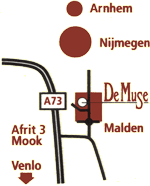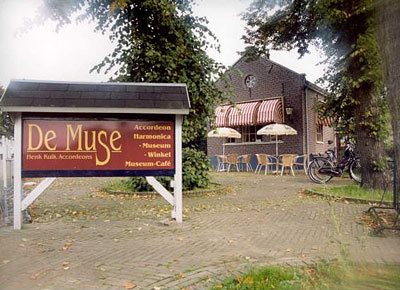 |
Opening Hours:
Henk Kuik Accordions: Wednesday till Saturday
11.00 am - 17.30 pm.
'De Muse' Museum: 12.00 am - 17.00 pm.
Special opening hours for groups by appointment.
At the same time is it possible to make use of the museumcafé
for special occasions or other festive activities.
Admission:
Adults 3.00 Euro,
Children 6-12 1.75 Euro
Under the age of 6 free admission |
Easy Access to 'De Muse':
By Bus/Traintaxi from Nijmegen station:
Bus No. 83 (halting place "Groesbeekseweg):
By car, highway A73, way out 3 Malden: Center of town opposite
Church and new Town Hall;
On Bike, by way of secondary highway or 'Broekkant' ( Maas-route).
|
|
'De Muse' is a unique combination of a museum, a music-café,
a accordionspecialtyshop and a repairworkshop. These components fertilize
each other and make iet a place where as much knowledge as possible is
collected in the field of reed-instruments. In this small but enjoyable
museum we like to give you an overview of the birth and evolution of the
accordion-family and their ancestors. No matter if you are a player yourself
or not, a visit to 'De Muse' is a pleasant experience in any case.
The Building
'De Muse' is situated in a historic building in the center of Malden.
In 1855 it was built as an extension to the then rectory (1799) to be used
as a primary school. Subsequently including barns and hay lofts it was
used as a farm house in the years 1910 till 1979.
Allowed to fall in total disarray, it took extensive re-building and
re-furbishment to bring it up to the standard requiered for our goal, which
are three independent activities.
The museum shop, Henk Kuik's accordion business and the museum restaurant
are situated on the ground floor. The entire first floor is reserved for
the Accordion and Harmonica Museum.
A short history....
The museum is situated in Malden, a lovely quiet village near the ancient
city of Nijmegen. It is one of four villages under the administration of
Heumen, the others are Nederasselt, Overasselt and part of Molenhoek. Malden
is closest to Nijmegen and the Interstate Highway, and this contributed
to the fact that it became the largest of them all.
Malden was first mentioned in 1247 when a treaty was signed witnessed
by Henrico Villico Maldene and Wilhelmo Maldene. Henrico was a public servant
who lived to the east side of the strongholt that had no name at the time.
On December 28, 1769, Malden was sold to the city of Nijmegen by 'Frederic
the Great' King of Prussia.
Malden itself lies between the rivers 'Maas' and 'Waal' and the German
border, a tourist's must for those seeking the Dutch country-side. Places
of interest; Arnhem, with its famous bridge across the river 'Waal'. Groesbeek,
where one of the largest war cemetries gives one the opportunity to remember
those who gave their lives for freedom. The German border towns of Goch,
Kleve, Emmerich and the ancient Roman village of Xanten are just a stone's
throw away.
Last but not least should be a visit to Nijmegen, "Noviomagus" where
the Romans built a wooden garrison for two legions, It was in 104 AD when
Emperor Marcus Ulpius Traianus granted the settlement market rights.
King 'Charles the Great' (Charlemagne) of France built his residence
there in the eighth century, and Emperor 'Frederic Barbarossa' built a
castle around the ruins of Charles the Great's resicence in the tenth century,
of which the remains can still be visited today.
In the twelfth century the city was called 'Numaga'. St. Stevens Church
(13th and 16th century), the Latin School (16th century) and the old Town
Hall (16th century) shows the wealth of that era. Many wars touched Nijmegen,
the longest was the eighty-year war. The peace negotiations lasted some
two years, and from this "Peace of Nijmegen" several beautiful tapestries
came about which are still displayed at the City Hall today.
The second world war is the most recent and well-known one. On February
22, 1944, the allies bombed the city, believing it was a German city. The
inner city was distroyed and some eight hundred and eighty civilians were
killed. Operation "Market Garden" took place on September 17 of that same
year. From September 1944 till March 1945, Nijmegen was in the front line
of the war.
Since the reconstruction of the city, archeological findings reveal
spectectular traces of the past, like for instance, parts of a Roman Bath
House with hot water facilities.
Interesting buildings and ruins in Nijmegen:
'Valkhof' - 'St. Nicolas chapel and ruins' - 'St. Martins chapel' -
'Stevens church' and the 'City Hall'.
For more information:
Friends of the Accordion and Harmonica Museum
Kerkplein 12
6581 AC Malden (near Nijmegen)
The Netherlands |

 Accordion & Harmonica Museum 'De Muse'
Accordion & Harmonica Museum 'De Muse'

 Accordion & Harmonica Museum 'De Muse'
Accordion & Harmonica Museum 'De Muse'